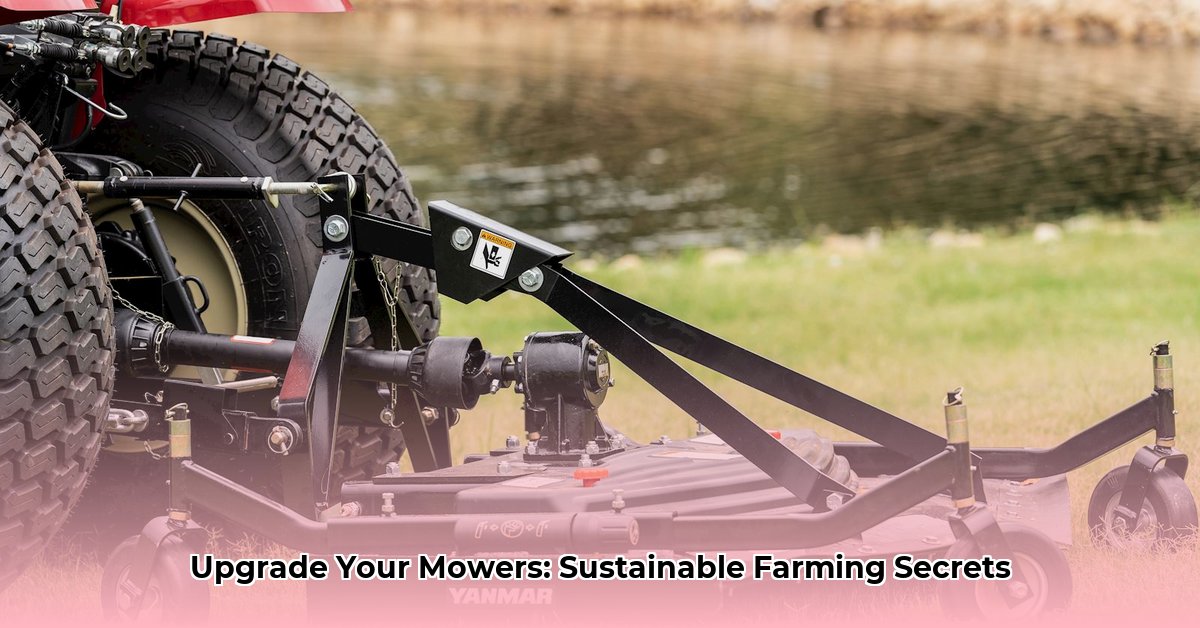
Choosing the right finish mower is crucial for efficient and sustainable farming. This guide provides a step-by-step process to help you select the ideal mower for your needs. For more information on compact tractor mowers, check out this helpful resource: Boom Mowers.
Understanding Your Tractor's Power and Mower Compatibility
Your tractor's power take-off (PTO) horsepower determines the size of mower it can handle. Using a mower too large for your tractor's PTO will lead to reduced cutting quality, equipment damage, and increased fuel consumption. Conversely, a mower too small will be inefficient, wasting your time and fuel.
Step 1: Determine your tractor's PTO horsepower. Consult your tractor's manual for the precise rating. This value represents the power available at the PTO shaft to drive implements.
Step 2: Check mower specifications. Mower manufacturers specify recommended PTO horsepower ranges for their models. Select a mower whose horsepower requirement falls within your tractor's capacity. Never exceed the maximum recommended PTO horsepower.
Step 3: Understanding the risks. Mismatching can result in costly repairs. An overpowered mower is less of an issue than an underpowered one, but still inefficient. Consult the following table for a general guideline:
| Tractor PTO Horsepower | Suggested Mower Deck Width (feet) |
|---|---|
| 20-30 hp | 4-5 feet |
| 30-40 hp | 5-6 feet |
| 40-50 hp | 6-7 feet |
| 50+ hp | 7+ feet |
Note: This is a general guideline. Always consult your tractor and mower manuals for precise specifications.
Choosing the Right Cutting Deck Width: Speed vs. Efficiency
The cutting deck width influences fuel efficiency and mowing time. A wider deck covers more ground per pass, reducing both time and fuel consumption. However, wider decks are less maneuverable, particularly in confined spaces.
Step 1: Assess your acreage and terrain complexity. Large, open fields benefit from wider decks for increased speed. Smaller fields with obstacles need narrower decks for better maneuverability.
Step 2: Consider fuel costs vs. labor costs. Wider decks might consume slightly more fuel per acre, but the time savings can offset this increase. Calculate the total cost per acre for different deck widths to find the optimal balance.
Step 3: Prioritize based on your needs. A busy farmer may prioritize speed, accepting a little higher fuel cost. A smaller farmer focused on cost-savings might opt for a narrower deck.
Discharge Methods: Side vs. Rear – Impacts on Sustainable Farming
Discharge methods significantly impact soil health and nutrient cycling. Rear discharge distributes clippings evenly, acting as natural fertilizer. Side discharge, while potentially more efficient for large areas, can lead to uneven distribution and clumping.
Step 1: Evaluate your sustainability goals. If maximizing soil health is a priority, rear discharge is generally preferred. Side discharge might be more suitable for large-scale operations where efficient mowing is paramount.
Step 2: Consider the visual appeal. Rear discharge generally provides a neater finish, while side discharge might leave uneven clippings.
Key Features to Look For: Building a Durable Mower
Several features significantly impact mower durability and performance:
Step 1: Assess your needs. Consider the following features and choose the ones most relevant to your farming operation:
- Floating Deck (Floating A-Frame): Essential for uneven terrain, enabling even cutting height.
- Blade Type: High-lift blades are better in tall grass, while low-lift blades suit short, fine grass.
- Deck Material: Steel offers superior durability but is heavier than aluminum.
- Cutting Height Adjustment: Allows for adaptable cutting heights based on different crops or terrain conditions.
- Safety Features: Prioritize safety features such as PTO safety switches and blade engagement mechanisms.
Step 2: Create a prioritized checklist. Rank these features based on their importance to your specific needs and budget.
Maintaining Your Mower for a Long Life
Regular maintenance extends your mower's lifespan and ensures optimal performance.
Step 1: Develop a maintenance schedule. This should include regular inspections for loose components, worn blades, and damaged belts.
Step 2: Implement regular tasks: Sharpen or replace blades regularly. Lubricate moving parts as recommended by the manufacturer. Clean the deck after each use to prevent buildup of grass and debris.
Step 3: Store properly. Store your mower in a dry place to protect it from rust and corrosion.
Comparing Brands: Factors to Consider
Brand comparison depends on available data for specific features. Look for reviews, independent testing, and user feedback to help inform your decision.
Step 1: Gather data. Utilize online resources, agricultural publications, and farmer forums. Note that complete long-term data may be limited.
Step 2: Prioritize your decision criteria. Focus on durability, performance, and maintenance requirements as key factors.
Step 3: Consider repair cost and parts availability. A brand with readily available and affordable parts can save you time and money in the long run.
Conclusion
Selecting the right finish mower involves a careful evaluation of your tractor's capacity, field characteristics, sustainability objectives, and maintenance practices. By following this guide, you can make an informed decision that optimizes your farming operation for efficiency and long-term performance. Remember to always consult your tractor and mower manuals for precise compatibility information.